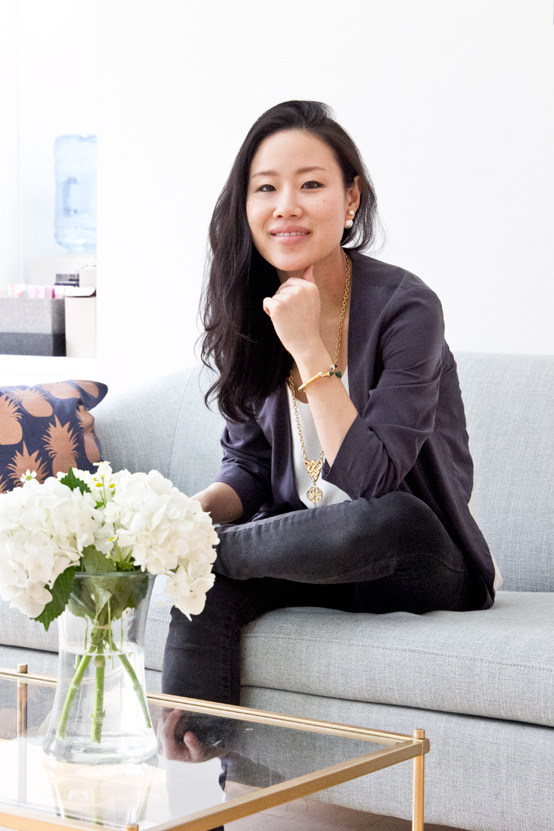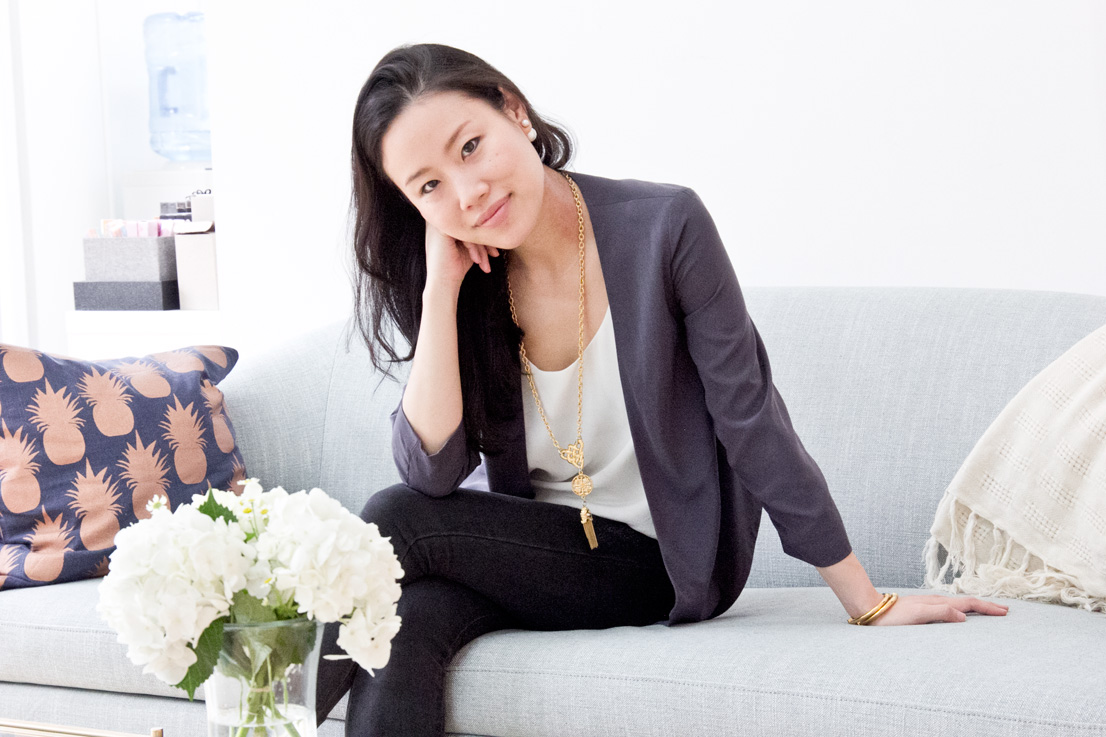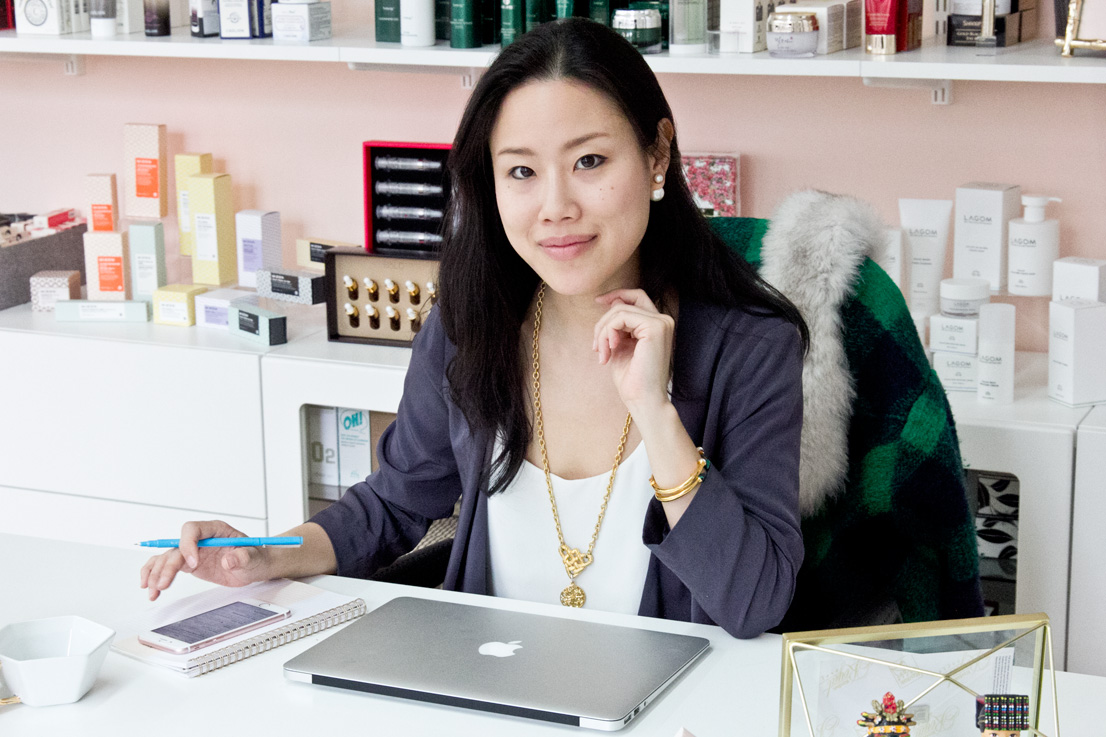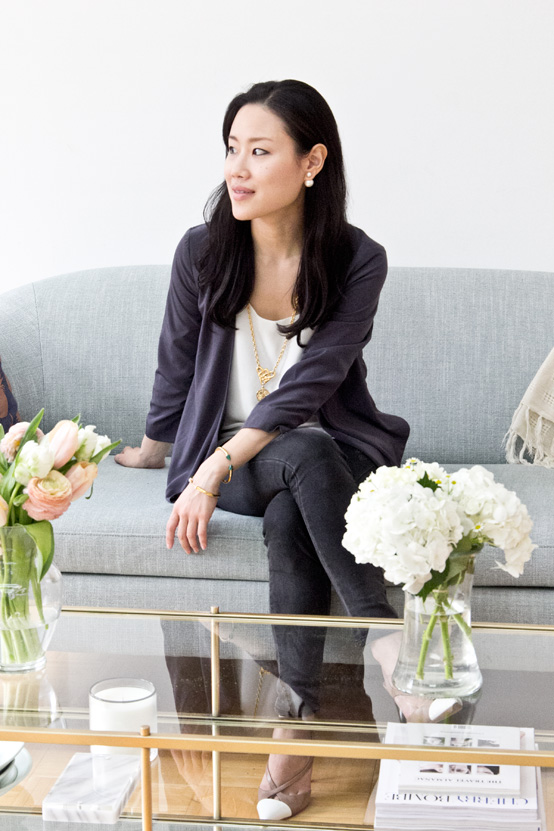 I moved around a lot when I was younger, but by the time I was five, we had more or less settled down in New York. I had a really happy childhood in New York. I attended this school with an alpha program where your classmates are basically the same from first grade until sixth grade. It was a really diverse group of kids and we all became really close. My best friend was Jewish and, even though I wasn’t, I ended up going to Hebrew School with her because we wanted to hang out with each other all the time. I was out in the park around playing in nature, did a lot of sports, played the violin and had a fun and carefree life. When I moved back to Korea when I was twelve, it was definitely a shock to the system. I went to an ‘international’ school where everything was taught in English, but it was pretty much 90% Korean and almost all the Korean students had been in Korea for some time. And that was just school; the whole country, especially back in the ‘90s, was still really homogenous – and not just in ethnic background but so much less diverse in other ways, too, like religious background and cultural nuances. Plus, I missed all my friends a lot. Then again, I was twelve, and at that age, I feel like it’s easier to adapt in some ways than when you’re a full-blown teenager. So within half a year or so, I was really well adjusted.
I moved around a lot when I was younger, but by the time I was five, we had more or less settled down in New York. I had a really happy childhood in New York. I attended this school with an alpha program where your classmates are basically the same from first grade until sixth grade. It was a really diverse group of kids and we all became really close. My best friend was Jewish and, even though I wasn’t, I ended up going to Hebrew School with her because we wanted to hang out with each other all the time. I was out in the park around playing in nature, did a lot of sports, played the violin and had a fun and carefree life. When I moved back to Korea when I was twelve, it was definitely a shock to the system. I went to an ‘international’ school where everything was taught in English, but it was pretty much 90% Korean and almost all the Korean students had been in Korea for some time. And that was just school; the whole country, especially back in the ‘90s, was still really homogenous – and not just in ethnic background but so much less diverse in other ways, too, like religious background and cultural nuances. Plus, I missed all my friends a lot. Then again, I was twelve, and at that age, I feel like it’s easier to adapt in some ways than when you’re a full-blown teenager. So within half a year or so, I was really well adjusted.
I studied at Columbia University. My high school was tiny – about 85 people in our graduating class. I wanted to go to a bigger school and having grown up mostly in New York City and Seoul, I knew I wanted to be in a big city with people from all different backgrounds. I also loved that Columbia offered a general liberal arts program with an interesting core curriculum that everyone has to take that covers everything from studying great thinkers and their philosophies to classic literature.
After graduating I joined Goldman Sachs as an analyst in their Credit Risk Management & Advisory group. Basically, I managed a portfolio of companies to analyse their capital structure and evaluate their credit worthiness for our trading group. I would then help structure trades to mitigate Goldman’s credit exposure to these companies. I would also help evaluate the credit risk in leveraged buyout transactions. I learned a ton, but I realized I didn’t love finance, and then went into consulting.
I was a consultant at both Accenture and the Boston Consulting Group for around four years. I loved my job! It was really exciting to explore the operational and strategic side of businesses rather than primarily analysing the financial side. For example, Time Warner Cable was one of our clients and they asked the question, “Should we invest $2bn into the wireless business?” and given that that was a big portion of their annual sales, that’s a really big question we had to answer. I also advised beauty clients since I loved the industry and the questions ranged from “how do we streamline marketing and education into a lower cost, high-impact method?” to “what is the best way to launch new product x into new market y?” It was fun to work across different functions in an organization and work so closely with the executive team in companies.
I really loved my job and so wasn’t thinking of going to business school. My manager and the head of my group had both gone to Harvard Business School and recommended that I apply. I remember my boss said, “I’m taking off my boss-hat and putting on my friend-hat. You should go to b-school, you’ll love it and get a lot out of it. Then, come back here.” I’m really grateful for his mentorship, and we’re still good friends today. He was primarily the impetus behind me getting an MBA.
My grandfather is a serial entrepreneur who’s built many successful businesses out of nothing. That was always inspiring to me. I wanted to build my own company, too, but wasn’t sure how. In business school, I launched a fashion showroom and ran it for a year – I brought over around 50 fashion designers from Korea, including Project Runway winners, and leading avant-garde designers and introduced them Stateside. The inventory sold out in the first three hours always, but sizing was a problem and I saw the business wasn’t scalable. I decided to do consulting again until I figured out a business model that would be exciting to me and be scalable. Even though I didn’t end up continuing with the fashion showroom, that gave me a taste of the start-up life, and I was totally hooked. It was incredibly invigorating to see an idea come into fruition and see everything you do have a direct impact in growing a business. Through trying to build a business, I realized that I’m an operator at heart, and I would much rather be building a business than advising a company.
BEAUTY AND PEACH & LILY
I grew up with severe eczema – still need to manage it. I never really thought the flaky skin, sometimes the bleeding skin and perpetually dry and rash-y face (and body) would be something that would go away. I grew up as a competitive platform diver, so being in and out of a pool probably didn’t help. I had an accident of sorts, ended up in a wheelchair for a bit, and pretty much ended my aspirations of pursuing diving as a career. By the time I was a senior in high school, without all the diving training, I had a lot more time on my hands. One day, just serendipitously, I was walking around Gangnam and this beautiful lady asked me to come take a test at her beauty school. I went and applied some makeup, and apparently, I was ‘artistic’ enough that I was invited to take complimentary classes at her school. I was much more drawn to the esthetician program and started studying everything about the skin with a lot of curiosity. I remember realizing that the skin is an organ and with a bit of knowledge and a more scientific approach, I could combat my eczema. That was the moment for me.
Taking care of my skin was just part of my lifestyle. I really viewed it as a form of overall wellness and self-care versus a hobby or vanity thing. It was just part of being healthy, like working out and trying to eat well. Because not a ton of my friends were that knowledgeable about skin as no one else I knew had really studied it in earnest, I was always eager to share about skincare and give facials and product recommendations to try to help them improve their skin whether it be fighting dry skin or acne. My friends from college pretty much say to me now, “it makes total sense you launched Peach & Lily,” even if I couldn’t have imagined doing beauty as a career back then. I always loved bringing them back products from Korea to try. I liked Saengreen products – they’re one of the oldest and largest natural beauty products brand and I found their products pretty gentle for my fragile skin, so I brought a lot of those over.
[show_shopthepost_widget id=”1568548″]
Peach & Lily curates the best Korean and Japanese beauty brands and sells them in North America, Europe, some parts of South America and beyond via our e-commerce site and through our stores in Macy’s. We also act as a distributor, so we sell the brands that we carry to Sephora, QVC, Target, Urban Outfitters, Anthropologies, boutiques, etc. In working as a consultant and advising beauty clients, I noticed that cosmetic chemists from the largest global beauty brands were saying that Korea has some of the most advanced skincare. I also noticed that beyond the mass brands, sort of like the Olay, Bath & Body Works, and Neutrogena’s of Korea, which were already available on Amazon and in stores throughout Korea town and Chinatown in the US, the more niche brands like the Tata Haper, Royal Fern Skincare, or Glossier’s of Korea were not available yet Stateside. It’s not so much that we don’t carry large more mass brands – we do if they have great formulations – but I wanted to answer the question: “Which brands are the ones celebrities in Korea with flawless skin are using – not which brands are they the models for.” When these A-listers go home, what are they doing and using that help them look absolutely radiant? And often times, they’re pointing to the niche spa or doctor brands and all the beauty insiders seem to love these brands and try as I might, they’re really hard to access from the States even if I look everywhere online. So Peach & Lily was born – sort of a personal passion to have access to the best from Korea even from NYC.
The introduction of BB Cream in 2011 was maybe the beginning of the K-beauty trend, but when I launched Peach & Lily in 2012, it was still really a nascent market. It took a lot of educating as the pioneer in this space to get the word out there. I think I saw a tipping point in late 2013, early 2014, and it was a really rewarding moment to see what could happen if I stuck to my guns and believe that Korean beauty could become more mainstream, even if it took some time. The Korean beauty innovations are fuelled by competition. With a hyper-competitive marketplace and an incredibly savvy and demanding consumer base, Korean beauty brands will only survive if they deliver on all fronts: products need to be gentle, more natural, high-performing, sensorially delightful, have great packaging, and have great value.
Beauty products in Korea aren’t all that different to what we see in the US or Europe; there are a lot of similarities, too. And in fact, western beauty brands are sometimes the source of inspiration for a lot of Korean beauty products, like the Bioderma cleansing water. That gave birth to a lot of different cleansing waters made by Korean brands. The beauty brands that do offer a point of difference usually have really interesting textures, use different ingredients, have innovative formulations, have neat applicators, and/or have fresh packaging.
It took a lot of educating as the pioneer in this space to get the word out there. I think I saw a tipping point in late 2013, early 2014, and it was a really rewarding moment to see what could happen if I stuck to my guns and believe that Korean beauty could become more mainstream, even if it took some time.
Great beauty brands are really careful about where their brand is retailed. The not-so-great brands were actually really eager to work with us – a company back then with no website, no consumers and no products! I didn’t want to curate these brands, though, and so signing on the brands that were really selective about the company they keep and the level of expertise that would be used to market and explain their brand and products were the ones I wanted and the ones that didn’t want to retail on Peach & Lily back then. I completely understood and knew I had to somehow demonstrate the care we would put into their brand, but also the commitment to not retail their products alongside brands that offer lacklustre products or just me-too knock-offs. It took lots of meetings, lots of presentations, lots of demonstrating knowledge about their formulations, in-depth explanations about how we would work as a retailer, and finally after five months, I signed on the first brand that I really, really wanted on board. After that brand – because the industry is small in some ways, and other brands know how careful this brand is – it was much easier to sign on similar brands.
Now, I travel to Korea every month, month and a half. I’m there beauty hunting, which means speaking to top dermatologists, estheticians, makeup artists, celebrities, store directors, consumers, and R&D labs to understand the latest and greatest trends. I’m in back to back meetings with current pipeline brands and lately, lots and lots of meetings with our partner R&D lab as we’re making our own sheet masks and we’ve been hard at work for over a year now!
In previous trips, there was more buzz about the quirky, stand-out products – the carbonating fizzing products and the out-there ingredients. This trip I spoke to a lot of consumers and there’s definitely a huge growing trend where consumers are looking towards the speciality clinic-developed brands for serious skincare. They want something that’s really going to work. No gimmicks. Gentle but extremely efficacious. There’s also an app everyone uses that lets you see how toxin-free a product is. So that’s trending, too. Healthy products. There’s less emphasis now on fun, entertaining products, but much more focus on healthy and high performing. There was one brand that kept coming up in this category, so we decided to curate that one after our usual three-week focus group testing stateside. Sure enough, this brand passed with high praises. I also personally tested this on my eczema flare-ups and it has a product that was the only one that really didn’t sting and soothed my skin. Stay tuned!
I always use oatmeal compresses on my skin, drink lots of water to keep toxins out and use a humidifier to to handle my eczema and try to stay away from sugars and dairy when it’s really bad. Depending on what is causing my eczema flare-up, I also find supplements to work well – sometimes oregano oil supplements help, sometimes Pau D’arco, sometimes bentonite clay detoxes. I do steam facials using the Cremorlab Aqua Essence Water Fluid. I used to use hydrocortisone, but over the long run, steroids were doing me more harm than good, so now I 100% avoid steroids.
I’m constantly trying new skincare products so my face is a lab of sorts! I have a few products I reach for to soothe skin whenever it’s gone through the wringer. I’ve been using these for four years now. I love Aromatica’s Natural Coconut Cleansing Oil – it’s all natural and so gentle, and smells amazing. Be The Skin’s Botanical Nutrition Power Toner with royal jell is insanely soothing and hydrating. And I can’t live with Calendula’s Juicy Cream moisturiser. It goes everywhere with me.
There isn’t really a limit on how long you should use the same product before changing. It’s more that your skin type can change, so you need to adapt with your skin. Also, some products over the long run can be more damaging than helpful depending on your skin type. For example, some people say using products with denatured alcohol can feel great at first, but over time, the skin barrier feels weaker and thinner. Same goes for retinol.
Lately, I’ve been swimming in the mornings so post-swim, I take a quick 5-minute shower. If my skin is feeling particularly dry, then I’ll do a steam-facial in the shower. After the shower, I’ll do my morning skincare routine – I’ve updated it a bit lately because swimming makes it so much drier than usual, which is already really dry. I used to do a tiny-drop of oil-cleanser to remove my night cream or sleeping pack, but I don’t double cleanse in the morning anymore because swimming seems to get everything completely off. I now start with a gentle water-based cleanser to cleanse down to pores without stripping my skin dry. I love S-Energy’s Facial Mousse Cleanser. It’s great for sensitive skin, and dry skin. It’s what the A-listers in Korea are using and I can see why – my skin is left so hydrated, clean, and radiant. I follow up with a hydrating toner like Be The Skin’s Botanical Nutritional Power Toner, which I’ve been using for four years, along with a hydrating essence like Cremorlab’s Aqua Essence Water Fluid. For me, essences are key to getting that dewy glow. Next, come the serums and face oils. Since I have dry skin, and am inclined to losing skin firmness given my thin skin texture, I focus primarily on four things: 1) more hydration, 2) firmness, 3) antioxidants to prevent aging, and 4) strengthening the skin barrier. For that, I use S-Energy’s Long Lasting Concentrated Serum – my holy grail serum that keeps my skin really plump and firm. Be The Skin’s Botanical Nutrition Power Serum keeps my skin hydrated and strong, which I mix with Aromatica’s Organic Argan Oil, as I need the lipids on my skin, plus this is filled with antioxidants. Lately, I’ve been using Dr Dream’s Age Radiance Power Essence to help boost radiance and combat hyperpigmentation. I don’t have uneven skin tone or acne scarring, but I started noticing a few sun spots and this rose stem cell extract and vitamin C cocktail gets it right out. While I apply my serums/face oils, I do facial massages that take about three minutes, just to work out the facial muscles a little and also help with circulation. I then seal everything in with Cremorlab’s Snow Falls Melting Cream, which is super hydrating and helps with anti-aging. Best of all, I love the texture of this cream, it’s a balm that melts into a soft lightweight texture leaving skin comfortable and feeling almost bare-faced.
I do some lightweight body stretches as I work out my face. I say the “a e i o u” in really exaggerated ways 3 times. I also massage my scalp quite vigorously for a good few minutes or so. This keeps the scalp refreshed and the muscles worked out a bit more. My skin teacher taught me back in Korea that sagging on the face begins with the scalp, so scalp massages (not only feel great!), but can do wonders for keeping skin firm. I’ve been doing this every morning and night for the last fifteen years now, so it’s d



